
Concept explainers
(a)
Interpretation: The equilibrium picture of 10 molecules of HA and HCl acid in their two separate aqueous solutions needs to be drawn.
Concept Introduction: An acid is the substance that gives H+ or
On the contrary, a weak acid ionized partially and reaches to equilibrium.
(a)
Answer to Problem 6DQ
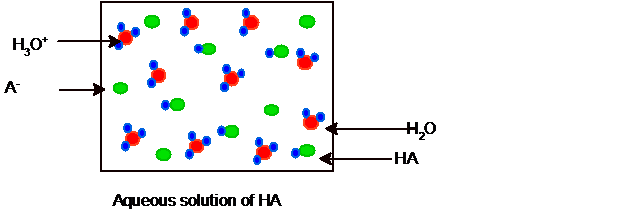
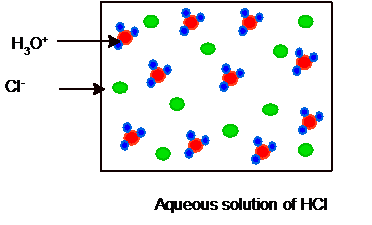
Explanation of Solution
HA is weak acid and HCl is a strong acid. For a weak acid HA, the ionization reaction can be written as:
Since it is partial ionization hence some molecules of HCl and water must be present in the solution and the picture of equilibrium can be shown as:
 Whereas HCl is a strong acid so it will ionize completely as given below. Hence no HCl and water molecules must be present in the solution.
Whereas HCl is a strong acid so it will ionize completely as given below. Hence no HCl and water molecules must be present in the solution.
Hence the picture of equilibrium can be shown as:
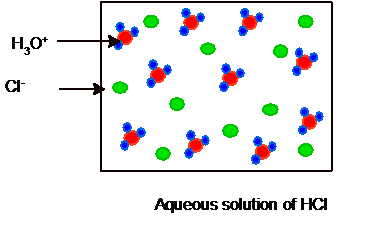
(b)
Interpretation: The major species in the two separate aqueous solution of HA and HCl acid needs to be determined.
Concept Introduction: An acid is the substance that gives H+ or
On the contrary, a weak acid ionized partially and reaches to equilibrium.
(b)
Answer to Problem 6DQ
Explanation of Solution
HA is weak acid and HCl is a strong acid. For a weak acid HA, the ionization reaction can be written as:
Whereas HCl is a strong acid so it will ionize completely as given below:
Hence the major species in both acids must be:
(c)
Interpretation: The Ka value from the equilibrium picture of 10 molecules of HA and HCl acid in their two separate aqueous solution needs to be calculated.
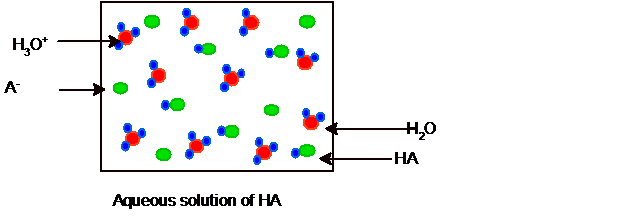
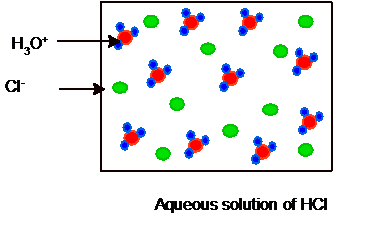 Concept Introduction: An acid is the substance that gives H+ or
Concept Introduction: An acid is the substance that gives H+ or
On the contrary, a weak acid ionized partially and reaches to equilibrium.
(c)
Answer to Problem 6DQ
Explanation of Solution
The Kaexpression for both acids can be written as given :
Substitute the values of number of molecules from each picture:
(d)
Interpretation: The order from strongest to weakest base for
Concept Introduction: An acid is the substance that gives H+ or
On the contrary, a weak acid ionized partially and reaches to equilibrium.
(d)
Answer to Problem 6DQ
Explanation of Solution
HA is weak acid and HCl is a strong acid. For a weak acid HA, the ionization reaction can be written as:
Whereas HCl is a strong acid so it will ionize completely as given below:
According to the Bronsted-Lowery acid-base theory, a strong acid gives H+ ions and form weak conjugate base whereas a strong base accepts H+ ion to form weak conjugate acid of it. Since HA is weak acid and forms
Want to see more full solutions like this?
Chapter 7 Solutions
Chemical Principles
- H CH3 CH3 b) Write the products of your compound and the following reagents. If the reaction would not work for your compound, write "no reaction" and explain the problem. NaCN H* H₂NNHCH5 H* -à NaBH -à CH2MgBr Cro₁₂ --à H3O+ -à c) Would your compound give a positive Tollen's test? Why or why not?arrow_forwardHomework 4 Chem 204 Dr. Hellwig Consider this compound, which will be referred to as "your compound". a) Name your compound according to the IUPAC system. Include stereochemistry (E/Z/R/S) H CH3 CH3arrow_forwardWhat is the mechanism for this?arrow_forward
- 21.50 Determine the combinations of haloalkane(s) and alkoxide(s) that could be used to synthesize the following ethers through Williamson ether synthesis. (a) (c) (d) (e) (f) H₂COarrow_forward1. Arrange the following in order of increasing bond energy (lowest bond energy first, highest bond energy last). Provide your rationale. C=C, C-F, C=C, C-N, C-C List the bond order for each example.arrow_forwardWhat is the major enolate formed when treated with LDA? And why that one?arrow_forward
- 4. Calculate the total number of sigma bonds and total number of pi bonds in each of the following compounds. a. HH :D: +1 I H-N-C-C-O-H I H b. HH H Н :N=C-C-C=C-CEC-H :0: total o H-C-H H-C = `C-H I H. 11 H-C = C= CH H total o total π total π 1 Harrow_forwardIn the following reaction, what quantity in moles of CH₃OH are required to give off 4111 kJ of heat? 2 CH₃OH (l) + 3 O₂ (g) → 2 CO₂ (g) + 4 H₂O(g) ∆H° = -1280. kJarrow_forwardIndicate the processes in the dismutation of Cu2O.arrow_forward
- 1. Consider these three reactions as the elementary steps in the mechanism for a chemical reaction. 2600 2400 2200 2000 1800 1600 1400 1200 1000 800 Potential Energy (kJ) 600 400 200 0 -200- -400 -600- -800 (i) Cl₂ (g) + Pt(s) → 2Cl (g) + Pt(s) (ii) Cl (g)+ CO (g) + Pt (s) → CICO (g) + Pt (s) Ea = 1550 kJ Ea = 2240 kJ (iii) Cl (g) + CICO (g) → Cl₂CO (g) Ea = 2350 kJ AH=-950 kJ ΔΗ = 575 ΚΙ AH=-825 kJ a. Draw the potential energy diagram for the reaction. Label the data points for clarity. The potential energy of the reactants is 600 kJ Reaction Progress b. What is the overall chemical equation? c. What is the overall change in enthalpy for the above chemical reaction? d. What is the overall amount of activation energy for the above chemical reaction? e. Which reaction intermediate would be considered a catalyst (if any) and why? f. If you were to add 2700kJ of energy to the reaction (e.g. 2700 kl of heat or electricity), would you be able to make the reaction reverse itself (i.e. have…arrow_forwarddraw the enolate anion and the carbonyl that would be needed to make this product through an aldol addition reaction.arrow_forwardDraw the Michael Adduct and the final product of the Robinson annulation reaction. Ignore inorganic byproducts.arrow_forward
 ChemistryChemistryISBN:9781305957404Author:Steven S. Zumdahl, Susan A. Zumdahl, Donald J. DeCostePublisher:Cengage Learning
ChemistryChemistryISBN:9781305957404Author:Steven S. Zumdahl, Susan A. Zumdahl, Donald J. DeCostePublisher:Cengage Learning Chemistry: An Atoms First ApproachChemistryISBN:9781305079243Author:Steven S. Zumdahl, Susan A. ZumdahlPublisher:Cengage Learning
Chemistry: An Atoms First ApproachChemistryISBN:9781305079243Author:Steven S. Zumdahl, Susan A. ZumdahlPublisher:Cengage Learning
 Chemistry & Chemical ReactivityChemistryISBN:9781337399074Author:John C. Kotz, Paul M. Treichel, John Townsend, David TreichelPublisher:Cengage Learning
Chemistry & Chemical ReactivityChemistryISBN:9781337399074Author:John C. Kotz, Paul M. Treichel, John Townsend, David TreichelPublisher:Cengage Learning Chemistry & Chemical ReactivityChemistryISBN:9781133949640Author:John C. Kotz, Paul M. Treichel, John Townsend, David TreichelPublisher:Cengage Learning
Chemistry & Chemical ReactivityChemistryISBN:9781133949640Author:John C. Kotz, Paul M. Treichel, John Townsend, David TreichelPublisher:Cengage Learning Chemistry: Principles and ReactionsChemistryISBN:9781305079373Author:William L. Masterton, Cecile N. HurleyPublisher:Cengage Learning
Chemistry: Principles and ReactionsChemistryISBN:9781305079373Author:William L. Masterton, Cecile N. HurleyPublisher:Cengage Learning





